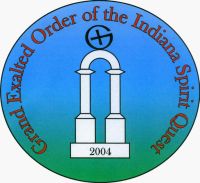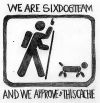“INDIANA
SPIRIT QUEST”

The Indiana Spirit Quest series of
geocaches will take you to a number of historic cemeteries
built by Hoosier Pioneers. In just a year and a half, the quest has
grown to over two hundred seventy caches hidden in twenty-seven
Indiana counties, and two Ohio counties, and the hiders have grown
to ten cacher teams, nine of which of which are comprised of
Dogs and their Humans. Over 560
cacher teams have logged over 6,400 finds. One cache machine found
102 ISQ caches in a single day (daylight hours
only).

(Photos by LEAD DOG)
INDIANA
SPIRIT QUEST #283
”THE VIKING DUKE!"
Welcome to Clunette Cemetery, Prairie
Twp., Koskiusko County, with burials dating back to the
1840's.
The coordinates at the top of the page
will not take you to the cache, but they will get you close. Once
you find the cemetery, you must find Sidney Hatfield's Grave stone.
Then march 66 feet on a heading of 105 degrees to find what you
seek.

SIDNEY HATFIELD,DESCENDANT OF THE VIKING DUKE OF NORMANDY WM
1ST KING OF ENGLAND AND ALFRED THE GREAT. SEE HATFIELD HOUSE
MEMOIRS AND BRITISH HISTORY.
We really don't see what all the hoopla is
all about. If you assume three generations per century and just two
children per family, Big Al would have 128 MILLION decendents in
just nine centuries, the vast majority alive today. Heck, we're
probably ALL related to the Great one...I know Patrick thinks HE
is...the little idiot.
There is identical wording on a tombstone in Milford
Cemetery. See the Gallery.
ALFRED THE GREAT
(871-900 AD)
Youngest son of King Æthelwulf, Alfred
became King of Wessex during a time of constant Viking attack. He
was driven into hiding by a Viking raid into Wessex, led by the
Dane, Guthorm, and took refuge in the Athelney marshes in Somerset.
There, he recovered sufficient strength to be able to defeat the
Danes decisively at the Battle of Eddington. As a condition of the
peace treaty which followed, Guthorm received Christian baptism and
withdrew his forces from Wessex, with Alfred recognizing the Danish
control over East Anglia and parts of Mercia. This partition of
England, called the "Danelaw", was formalized by another treaty in
886.
Alfred created a series of
fortifications to surround his kingdom and provide needed security
from invasion. The Anglo-Saxon word for these forts, "burh", has
come down to us in the common place-name suffix, "bury." He also
constructed a fleet of ships to augment his other defenses, and in
so doing became known as the "Father of the English Navy." The
reign of Alfred was known for more than military success. He was a
codifier of law, a promoter of education and a supporter of the
arts. He, himself, was a scholar and translated Latin books into
the Anglo-Saxon tongue. After his death, he was buried in his
capital city of Winchester, and is the only English monarch in
history to carry the title, "the Great."
WILLIAM THE
CONQUEROR
(1066 -1087)
William, the
illegitimate son of the Duke of Normandy, received the duchy of
Normandy upon his father's death in 1035. A council consisting of
noblemen and William's appointed guardians ruled Normandy but ducal
authority waned under the Normans' violent nature and the province
was wracked with assassination and revolt for twelve years. In
1047, William reasserted himself in the eastern Norman regions and,
with the aid of France's King Henry I, crushed the rebelling
barons. He spent the next several years consolidating his strength
on the continent through marriage, diplomacy, war and savage
intimidation. By 1066, Normandy was in a position of virtual
independence from William's feudal lord, Henry I of France and the
disputed succession in England offered William an opportunity for
invasion.
William immediately prepared to invade
England. Prepared for battle in August 1066, ill winds throughout
August and most of September prohibited him crossing the English
Channel. This turned out to be advantageous for William, however,
as Harold Godwinson awaited William's pending arrival on England's
south shores, Harold Hardrada, the King of Norway, invaded England
from the north. Harold Godwinson's forces marched north to defeat
the Norse at Stamford Bridge on September 25, 1066. Two days after
the battle, William landed unopposed at Pevensey and spent the next
two weeks pillaging the area and strengthening his position on the
beachhead. The victorious Harold, in an attempt to solidify his
kingship, took the fight south to William and the Normans on
October 14, 1066 at Hastings. After hours of holding firm against
the Normans, the tired English forces finally succumbed to the
onslaught. Harold and his brothers died fighting in the Hastings
battle, removing any further organized Anglo-Saxon resistance to
the Normans. The earls and bishops of the witan hesitated in
supporting William, but soon submitted and crowned him William I on
Christmas Day 1066. The kingdom was immediately besieged by minor
uprisings, each one individually and ruthlessly crushed by the
Normans, until the whole of England was conquered and united in
1072. William punished rebels by confiscating their lands and
allocating them to the Normans. Uprisings in the northern counties
near York were quelled by an artificial famine brought about by
Norman destruction of food caches and farming implements.( Tough
Luck if you're an Anglo Saxon--Lead Dog).
The arrival and conquest of William and
the Normans radically altered the course of English history. Rather
than attempt a wholesale replacement of Anglo-Saxon law, William
fused continental practices with native custom. By disenfranchising
Anglo-Saxon landowners, he instituted a brand of feudalism in
England that strengthened the monarchy. Villages and manors were
given a large degree of autonomy in local affairs in return for
military service and monetary payments. The Anglo-Saxon office of
sheriff was greatly enhanced: sheriffs arbitrated legal cases in
the shire courts on behalf of the king, extracted tax payments and
were generally responsible for keeping the peace. "The Domesday
Book" was commissioned in 1085 as a survey of land ownership to
assess property and establish a tax base. Within the regions
covered by the Domesday survey, the dominance of the Norman king
and his nobility are revealed: only two Anglo-Saxon barons that
held lands before 1066 retained those lands twenty years later. All
landowners were summoned to pay homage to William in 1086.
Although he began the invasion with papal support, William
refused to let the church dictate policy within English and Norman
borders. He died as he had lived: an inveterate warrior. He
died September 9, 1087 from complications of a wound he received in
a siege on the town of Mantes.
FIND LOGS ON THIS CACHE THAT
INDICATE NIGHT CACHING WILL BE DELETED WITHOUT
NOTICE!
 The cache container
is a 35mm film can. BYOP.The cache is not located near a
grave... If you find a fallen US flag, please stick it back in
the ground. As always, please be respectful, and cache in,
trash out. XXXXX
The cache container
is a 35mm film can. BYOP.The cache is not located near a
grave... If you find a fallen US flag, please stick it back in
the ground. As always, please be respectful, and cache in,
trash out. XXXXX
None genuine without this official SixDogTeam
seal. Digital photographs taken by Lead Dog, (C) 2005 by RikSu
Outfitters unless otherwise noted.
 XXXXXXXXXX
XXXXXXXXXX
"Indiana
Spirit Quest" is brought to you by the following fellows of
GEOISQ*: SixDogTeam (Earthdog Patrick, Lead Dog, Wheel Dog) Kodiak
Kid, THE SHADOW, Team Shydog, Rupert2, Torry, ~Mystery Dog~, Team
Tigger International, Cache Commando, bbSurveyors and Dover Duo. If
you are interested in spreading the Quest to your neck of the woods
AND WOULD LIKE TO JOIN US, email
SixDogTeam.
*Grand Exalted Order of
the Indiana Spirit
Quest

xxxxx